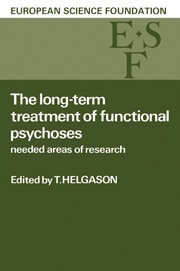Book contents
- Frontmatter
- Contents
- List of Participants
- Introduction
- I Organisational Aspects of Long-term Treatment
- II Patients Aspects of Long-term Treatment
- III Public Health Aspectsof Long-term Treatment
- Introduction to public health aspects of chronic illness and long-term treatment
- Evaluation of long-term community care for patients with schizophrenia
- Case registers for monitoring treatment outcome in chronic functional psychoses
- Socialdisabilityand chronicmentaldisorder
- The neglect of the patient with chronic functional psychosis: the need for further research
- Suicidesand functional psychoses
- Interaction with families
- Cost-effectiveness analysis
- Consumption of services-European aspects
- Index
Suicidesand functional psychoses
from III - Public Health Aspectsof Long-term Treatment
- Frontmatter
- Contents
- List of Participants
- Introduction
- I Organisational Aspects of Long-term Treatment
- II Patients Aspects of Long-term Treatment
- III Public Health Aspectsof Long-term Treatment
- Introduction to public health aspects of chronic illness and long-term treatment
- Evaluation of long-term community care for patients with schizophrenia
- Case registers for monitoring treatment outcome in chronic functional psychoses
- Socialdisabilityand chronicmentaldisorder
- The neglect of the patient with chronic functional psychosis: the need for further research
- Suicidesand functional psychoses
- Interaction with families
- Cost-effectiveness analysis
- Consumption of services-European aspects
- Index
Summary
The changing patterns of suicide in European countries during the last two decades were discussed by a World Health Organization (WHO) Working Group at a meeting in Athens, 29 September-2 October 1981. Some of the conclusions presented in the report (WHO, 1982) provide a useful background for a discussion of the topic of suicides and functional psychoses.
The WHO working group found the following trends in suicide be haviour worthy of further investigations:
the rising rates of suicide in most European countries, which have now reached particularly high levels in Hungary and in the northern parts of Yugoslavia;
the exceptional decline in rates in England & Wales and in Greece during the last two decades;
the relatively low rate in Norway compared with other Scandinavian countries;
the marked increase in rates for elderly women in most European countries;
the marked increase in rates for young adults in most European countries.
The working group related the changes in reported suicide rates to the social and economic changes in societies that are likely to lead to social isolation of individuals. The following categories were considered high-risk groups for suicide:
persons known to be subject to depressive illness,
psychiatric hospital in-patients,
those who have attempted suicide,
alcoholics.
A large number of investigations in various countries have shown that a considerable proportion (at least one third) of those who commit suicide are psychotics: i.e. patients with depressions (with endogenous as well as reactive depressions), schizophrenia or psychoorganic syndromes. Several studies report that 10-15% of manic-depressive patients will end their life by comitting suicide, and a similar suicide risk has been found among schizophrenic patients.
Within recent years a considerable increase in suicide among patients in psychiatric institutions has been reported from Norway, Finland, The Netherlands, UK and other countries. In Norway, the rates were eight times higher in 1970-4 than in 1950-3 (Hessø, 1977; Retterstøl, 1978).
The increasing suicide behaviour in the general population and among psychiatric patients in the Scandinavian countries has given rise to concern, not only among psychiatrists, but also among those responsible for the medical care and social development of the Scandinavian societies.
- Type
- Chapter
- Information
- The Long-Term Treatment of Functional PsychosesNeeded Areas of Research, pp. 235 - 240Publisher: Cambridge University PressPrint publication year: 1985

